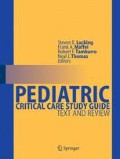Abstract
The study of hemodynamics began in 1628 with William Harvey’s description of the circulation of blood. Hemodynamics describes the complex interactions between cardiac function, vascular pressure, resistance and volume. An alteration in any of these variables can have profound physiological consequences. In order to support the cardiovascular system during a variety of disease states, an appreciation of the available assessment tools used to evaluate cardiac function and hemodynamics is essential. This chapter will focus on the utility and limitations of noninvasive and invasive measures of cardiac function and hemodynamics.
Access this chapter
Tax calculation will be finalised at checkout
Purchases are for personal use only
Suggested Readings
Texts
Bissonnette B. Pediatric anesthesia: principles and practices. 1st ed. New York: McGraw-Hill; 2002.
Civetta JM, Taylor RW, Kirby RR. Critical care. 3rd ed. Philadelphia: Williams and Wilkins; 1997.
Marino PL. The ICU book. 2nd ed. Philadelphia: Williams and Wilkins; 1997.
Mark JB. Atlas of cardiovascular monitoring. 1st ed. New York: Churchill Livingstone; 1998.
Mihm FG, Rosenthal MH. Pulmonary artery catheterization. In: Benito JL, editor. Clinical procedures in anesthesia and intensive care. Philadelphia: JB Lippincott; 1994. p. 416.
Miller RD. Anesthesia. 5th ed. Philadelphia: Churchill Livingstone; 2000.
Pulmonary artery education project http://www.pacep.org/pages/htmlos/10409.15.579661138558047482. Released 2001, Reviewed 2004, 2007.
Rhoades RA, Tanner GA. Medical physiology. 1st ed. Baltimore: Williams and Wilkins; 1995.
Rogers MC, Nichols DG. Textbook of pediatric intensive care. 3rd ed. Baltimore: Williams and Wilkins; 1996.
Sparkes HV, Rooke TW. Essentials of cardiovascular physiology. Minneapolis: University of Minnesota Press; 1987.
Tobin MJ. Principles and practices of intensive care monitoring. New York: McGraw-Hill; 1998.
Articles
Barach P. Pulsus paradoxus. Hosp Physician. 2000;1:49–50.
Barbeito A, Marks JB. Arterial and central pressure monitoring. Anesthesiol Clin. 2006;24:717–35.
Barber BJ, Donnerstein RL, Secomb TW, et al. Dicrotic pulse following Ross procedure. Pediatr Cardiol. 2007;28:247–9.
Bloos F, Reinhart K. Venous oximetry. Intensive Care Med 2005;31:911–913.
Cholley BP, Payen D. Noninvasive techniques for the measurement of cardiac output. Curr Opin Crit Care. 2005;11:424–9.
Connors A, Speroff T, Dawson NV, et al. The effectiveness of right heart catheterization in the initial care of critically ill patients. JAMA. 1995;274:1591–8.
Das BB. Plasma B-type natriuretic peptides in children with cardiovascular diseases. Pediatr Cardiol. 2010;31:1135–1145.
Godje O et al. Reliability of a new algorithm for continuous cardiac output determination by pulse-contour analysis during hemodynamic instability. Crit Care Med. 2002;30:52–8.
Hadian M, Pinsky MR. Functional hemodynamic monitoring. Curr Opin Crit Care. 2007;13:318–23.
Hofer CK, Ganter MT, Zollinger A. What technique should I use to measure cardiac output? Curr Opin Crit Care. 2007;13:308–17.
King MA, Garrison MM, Vavilala MS, et al. Complications associated with arterial catheterization in children. Pediatr Crit Care Med. 2008;9:367–71.
Kleinman B. Understanding natural frequency and damping and how they relate to the measurement of blood pressure. J Clin Monit. 1989;5:137–47.
Lorente L, Santacreu R, Martin M, et al. Arterial catheter-related infection of 2,949 catheters. Crit Care. 2006;10:1–7.
Lucet JC, Bouadma L, Zahar JR, et al. Infectious risk associated with arterial catheters compared to central venous catheters. Crit Care Med. 2010;38:1030–5.
McGee DC, Gould MK. Preventing complications of central venous catheterization. N Engl J Med. 2003;348:1123–33.
McGhee BH, Bridges EJ. Monitoring arterial blood pressure: what you may not know. Crit Care Nurs. 2002;22:60–79.
McLaughlin DP. Pulsus alternans. N Engl J Med. 1999;341(13):955.
Mohan UR, Britto J, Habibi C, et al. Noninvasive measurement of cardiac output in children. Pediatr Cardiol. 2002;23:58–61.
Morgan P, Al-Subaie N, Rhodes A. Minimally invasive cardiac output monitoring. Curr Opin Crit Care. 2008;14:322–6.
Pizov R, Cohen M, Weiss Y, et al. Positive end expiratory pressure-induced hemodynamic changes are reflected in the arterial pressure waveform. Crit Care Med. 1996;24:1381–7.
Preisman S, Pfieffer U, Lieberman N, Perel A. New monitors of intravascular volume: a comparison of arterial pressure waveform analysis and the intrathoracic blood volume. Intensive Care Med. 1997;23:651–7.
Ricardo Vieira Carlos, Cristina Salvadori Bittar, Marcel Rezende Lopes, José Otávio Costa Auler Júnior Systolic pressure variation as diagnostic method for hypovolemia during anesthesia for cardiac surgery Brazilian Journal of Anesthesiology, 2005;55:1:3–18.
Reuter DA, Kirchner A, Felbinger TW et al. Usefulness of left ventricular stroke volume variation to assess fluid responsiveness in patients with reduced cardiac function. Crit Care Med. 2003;31:1399–1404.
Rivers EP, Ander DS, Powell D. Central venous saturation monitoring in the critically ill patient. Curr Opin Crit Care. 2001;7:204–11.
Sevransky J. Clinical assessment of hemodynamically unstable patients. Curr Opin Crit Care. 2009;15:234–8.
Shekerdemian L, Bohn D. Cardiovascular effects of mechanical ventilation. Arch Dis Child. 1999;80:475–80.
Tavernier B, Malchotine O, Lebuffe G, et al. Systolic pressure variation as a guide to fluid therapy in patients with sepsis-induced hypotension. Anesthesiology. 1998;89:1313–21.
Vernon C, Letourneau JL. Lactic acidosis: recognition, kinetics and associated prognosis. Crit Care Clin. 2010;26:255–83.
Yoshioka N. Do radial arterial pressure curves have diagnostic validity for identify severe aortic stenosis? J Anesth. 2010;24(1):7–10.
Author information
Authors and Affiliations
Corresponding author
Editor information
Editors and Affiliations
Rights and permissions
Copyright information
© 2012 Springer-Verlag London Limited
About this chapter
Cite this chapter
Maffei, F.A. (2012). Assessment of Cardiovascular Function. In: Lucking, S., Maffei, F., Tamburro, R., Thomas, N. (eds) Pediatric Critical Care Study Guide. Springer, London. https://doi.org/10.1007/978-0-85729-923-9_5
Download citation
DOI: https://doi.org/10.1007/978-0-85729-923-9_5
Published:
Publisher Name: Springer, London
Print ISBN: 978-0-85729-922-2
Online ISBN: 978-0-85729-923-9
eBook Packages: MedicineMedicine (R0)

